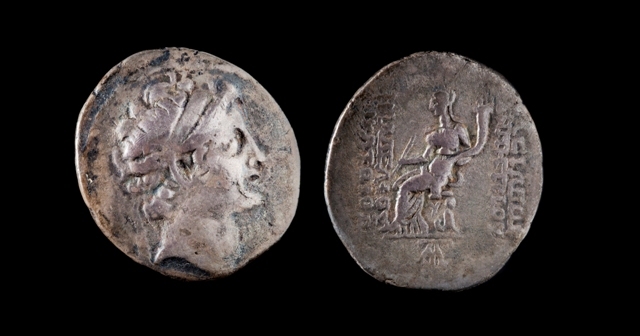Demetrios II Nikator, Silver Tetradrachm
Dublin Core
Title
Demetrios II Nikator, Silver Tetradrachm
Subject
Demetrios II Nikator, First Reign, Silver Tetradrachm, Seleucia on the Tigris mint, 145-138 BCE.
OBVERSE: Demetrius II in profile, facing right. Diademed head, inset in solid circle.
REVERSE: Tyche seated on backless throne, cradling a cornucopia in her left arm, holding a scepter in her right hand. The right leg of the throne has the form of a winged Tritoness (snake-bodied nymph). On right side of throne is inscribed "BASILEWS DHMHTRIOY" (= Basileos Demetriou, "of king Demetrios," on the left side "FILADELFOY NIKATOPOS" (= Philadelphou Nikatoros, "friend of his sibling, victor." AYT monogram in exergue.
OBVERSE: Demetrius II in profile, facing right. Diademed head, inset in solid circle.
REVERSE: Tyche seated on backless throne, cradling a cornucopia in her left arm, holding a scepter in her right hand. The right leg of the throne has the form of a winged Tritoness (snake-bodied nymph). On right side of throne is inscribed "BASILEWS DHMHTRIOY" (= Basileos Demetriou, "of king Demetrios," on the left side "FILADELFOY NIKATOPOS" (= Philadelphou Nikatoros, "friend of his sibling, victor." AYT monogram in exergue.
Description
Demetrios II Nikator ascended to the throne at only 14-16 years of age. This coin is from the first years (145-138 BCE) of his relatively long but tumultuous reign. In order to take control of the dwindling Seleucid empire, Demetrios had to overcome a usurper, Alexander I Balas, who had defeated and killed his father, Demetrios I Soter (162-150 BCE). Success only came when Ptolemy VI changed his alliance and gave his daughter, Cleopatra Thea, who was first married to the ursurper, Alexander I Balas, to Demetrios II Nikator along with his military support.
Another usurper, Diodotos Tryphon, was not long behind and, unable to regain control, Demetrios engaged in a different military campaign against the Parthians. He was captured under the reign of Mithradates I and held for nine years until his younger brother, Antiochos VII, who had defeated Diodotos, attacked the Parthian border. Demetrios was released to fight against his brother but Antiochus VII died in battle before any fighting could happen between the brothers. Demetrios was then free to rule his remaining empire (129 BCE), which he did until he was murdered in Tyre in 126 BCE.
Tyche, the personification of good fortune, was a common feature of the Seleucid’s coinage; the founder of the dynasty, Seleucus I Nikator (king from 305-281 BCE), had dedicated a temple to Tyche in his capital, Antioch-on-the-Orontes. The temple housed a famous bronze statue of Tyche by the sculptor Eutychides.
Another usurper, Diodotos Tryphon, was not long behind and, unable to regain control, Demetrios engaged in a different military campaign against the Parthians. He was captured under the reign of Mithradates I and held for nine years until his younger brother, Antiochos VII, who had defeated Diodotos, attacked the Parthian border. Demetrios was released to fight against his brother but Antiochus VII died in battle before any fighting could happen between the brothers. Demetrios was then free to rule his remaining empire (129 BCE), which he did until he was murdered in Tyre in 126 BCE.
Tyche, the personification of good fortune, was a common feature of the Seleucid’s coinage; the founder of the dynasty, Seleucus I Nikator (king from 305-281 BCE), had dedicated a temple to Tyche in his capital, Antioch-on-the-Orontes. The temple housed a famous bronze statue of Tyche by the sculptor Eutychides.
Source
Gift of James and Aneta McIntyre, Hallie Ford Museum of Art, Salem, OR. 2006.010.021
Date
146-140 BCE
Rights
Hallie Ford Museum of Art
Format
2.660 cm
14.900 gr
14.900 gr
Language
Greek
Type
Coin
Coverage
This item can be viewed on Hallie Ford Museum of Art's website.
Citation
“Demetrios II Nikator, Silver Tetradrachm,” Hallie Ford Museum of Art Exhibits, accessed January 3, 2026, https://library.willamette.edu/hfma/omeka/items/show/73.
